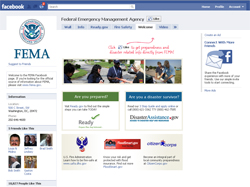9-1-1 Friend Request
A topic being hotly debated in our industry is the use of social media. Facebook, Twitter and other Web 2.0 tools have become a component of our daily lives. Social and professional networking platforms are a quick, easy way to disseminate a message — whether that message is about your dinner or the latest vampire movie. But do they fit into the public safety mission? If so, where?
A 2009 study on social media use showed 34% of Internet users use Web sites as their primary source of news, compared with newspapers and TV news, and 44% of Internet users read blogs.[1] According to a May 2010 article, the Washington Post has felt the effects of this usage. The paper has a print circulation of 665,000, and its online version gets more than 9.4 million unique visitors monthly — worldwide.[2] Additionally, Facebook has about 200 million active users worldwide,[3] and YouTube gets about 100 million daily views worldwide.[4] That’s tremendous reach.
Public safety agencies are already using these tools for outreach. At the national level, FEMA and the National Weather Service use Facebook to distribute public-safety-related information, including videos and public service announcements before, during and after disasters. Earlier this year, FEMA and the Tennessee Emergency Management Agency released a joint Facebook page to provide information to the state’s flood victims and updates on recovery efforts. Also, on Facebook you’ll find a page for the Benton County (Ark.) Emergency Services Agency and a page for the Boston PD.
Fairfax County, Va., posts PSAs and preparedness messages on its own YouTube channel. It also has a Twitter account (www.twitter.com/fairfaxcounty) and tweets on such topics as child fingerprinting events and disaster preparedness.
If your agency doesn’t want to use a traditional social networking method, it can always start its own. The Los Angeles Fire Department hosts a blog (www.lafd.blogspot.com) to assist with fire prevention and public education, and the Los Angeles Police Department hosts a blog (www.lapdblog.org) for press releases and public information, as well as job ads.
APCO International uses various methods to educate and share information. Look for APCO on Facebook, Twitter and YouTube; and many APCO chapters have their own accounts. In addition, APCO has officially launched the world’s only professional networking site dedicated to public safety communications, PSConnect (www.psconnect.org).
These tools can work for public safety, but how do you get started? The first step is to decide what tool(s) your agency will use. Look at sites created by other agencies to determine what will work for you.
Next, you should handle implementation as you would any other agency initiative. Develop policies and procedures and personnel rules, and determine your level of resource and financial need, which should be minimal because most of these sites are free and fairly simple.
You’ll need to decide who’s responsible for updating these sites. Can anyone in the agency post to the site? Or will it be restricted to one or two people? Also, you’ll need to develop a policy for whether or not employees can link their personal accounts to the agency account. How will those personal accounts reflect on the agency? Will employees have access to the agency and/or their personal accounts on duty? These and other issues need to be discussed.
The bottom line: A public safety agency’s failure to incorporate social and professional networking platforms into its public education process is a missed opportunity to exponentially increase public outreach — at little to no cost to the agency.
About the Author
Bob Smith is APCO International’s director of strategic development. Contact him via e-mail at smithr@apcointl.org.
References
1. Pew Internet & Family Life Project: “Growth in Use of Online Social Networks.” 2009.
2. Kurtz H: “Lack of vision to blame for newspaper woes.” Washington Post. May 11, 2010. Accessed August 2010: www.washingtonpost.com/wp-dyn/content/article/2009/05/10/AR2009051002044.html.
3. Ortutay B: “Fast-Growing Facebook’s User Base Hits 200 Million.” Associated Press. April 8, 2009.
4. Shark AR: “Leading in a Growing Technology Environment: Promises & Regrets.” Presentation at the 2009 Annual APCO Conference & Exposition.
Resources
- APCO Facebook: www.facebook.com/pages/daytona-beach-FL/APCO-International/7857109617
- APCO Twitter: www.twitter.com/APCOIntl
- APCO YouTube: www.youtube.com/apcomembership
- PSConnect: www.psconnect.org
- FEMA YouTube Channel: www.youtube.com/FEMA
- Fire EMS Blogs: http://fireemsblogs.com
- Law Officer Connect: http://connect.lawofficer.com
- Montgomery County (Pa.) 9-1-1 Facebook Page: www.facebook.com/Montco911
Originally published in Public Safety Communications, Vol. 76(10): 16, October 2010.


